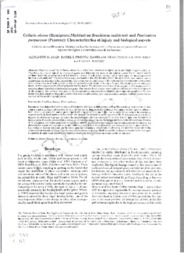Collaria oleosa (Hemiptera:Miridae) on Brachiaria ruziziensis and Penissetum purpureum (Poaceae): Charaterization of injury and biological aspects.
Collaria oleosa (Hemiptera:Miridae) on Brachiaria ruziziensis and Penissetum purpureum (Poaceae): Charaterization of injury and biological aspects.
Author(s): AUAD, A. M.; PIMENTA, D. S.; SILVA, D. M.; MONTEIRO, P. H.; RESENDE, T. T. de
Summary: Injuries caused by Collaria oleosa have often been observed in signal grass and elephant grass pastures. Therefore, the aim of this study was to diagnose and delineate the sites of the injuries caused by C. oleosa and to evaluate some biological aspects of this insect on forage. The duration and survival of the instars and nymph phase of the pest were analyzed. The epidermises were evaluated to identify the sites where the style of the pest entered and to characterize the anatomy of the injured site. The stoma was the entry place of the style and the main injuries were caused to the chlorenchyma of both grasses, and to the parenchymatic sheath of the signal grass. The lignified sheath remained intact, so this appears to be a feeding barrier for the insect. The duration was shorter from second to fifth instars and the nymphal phase when fed with the elephant grass. The way the food sources were hydrated did not alter the development of the nymphs. The survival was greater for the specimens maintained on elephant grass and the nymphs of the first instar were less sensitive when the grass blades were maintained on agar. This hydration method was also better for the survival of the mirid’s nymph phase.
Publication year: 2011
Types of publication: Journal article
Unit: Embrapa Dairy Cattle
Keywords: Plant bug, forage, plant anatomy
Observation
Some of Embrapa's publications are published as ePub files. To read them, use or download one of the following free software options to your computer or mobile device. Android: Google Play Books; IOS: iBooks; Windows and Linux: Calibre.
Access other publications
Access the Agricultural Research Database (BDPA) to consult Embrapa's full library collection and records.
Visit Embrapa Bookstore to purchase books and other publications sold by Embrapa.

